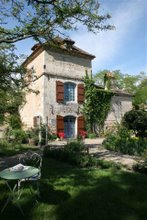
Some friends can’t imagine why I have never been to Ferran Adria’s El Bulli; it is, literally, just around this corner of Cap Creus at Rosas and I come here often. I will go someday. Perhaps. If I have nothing better to do. Today, I have something much better to do—lunch with friends at the end of the dock that serves the vanishing fishing fleet of Portlligat. Clotilde and I, en vacances in Cadaqués, are invited for a Sunday lunch of arroz de clavos- rice with shellfish. They’ll cook and I’ll watch, listen and… remember.
I remember nights when I listened to the hiss of gas lanterns from a couple dozen boats on this flat sea. Salvador Dali was still alive, the tourists had not yet arrived, and I had just bought the Julia Hoyt. Today there are only a couple active fishing boats but my dear friend Moises Tibau, Catalan artist, still fishes with his salty mentor, Benito, for escorpio, rape, calamar and langoustes. His paintings and ceramics grow like rampant sea fennel on this still wild rocky cape in a studio amid an olive grove overlooking the wide blue sea. I love his triptych of a knife, fork and spoon painted in squid ink and sardine oil on parchment paper. Moises paints like he cooks and fishes—with passion.
MT has prepared a box of Catalan ingredients to take to the port- onions, garlic, green peppers, homemade tomato sauce, rice, and two frozen bottles of fish stock. We jump in and on scooters, 4x4’s and shank’s pony to meet up just past the Dali House Museum and in front of Gala’s chrome yellow fishing boat. While Frederico takes a group of tourists for a boat ride along the rocks and coves, Moises and Isca prepare the Rice and Crab. As Quique chills the cava, Corrine, Adele, Clotilde and I, les filles, head for the beach across the bay.
Like barbeques everywhere, this is man’s work in man’s sacred sanctuary. Fishing nets and traps form the edges of this Mediterranean Kitchen garden where squid baskets, lines, buoys and floats grow like colorful flowers. In the middle of this nautical chaos is a stone-lined cooking area with two orange propane bottles attached to two gas tripods. A pot steams on each tripod: the monkfish head bouillon simmers on one; a dozen deepwater crabs, chunks of calamari, mussels and one fat lobster joins the rice and onion, garlic and pepper—a classic sofregit on the other. The bouillon is ladled over, one cup at a time; think creamy risotto, not dried-out restaurant paella.
A table is set under a shady net awning, plastic tumblers of cava are poured and we sit to eat from the large cast iron cazuela brought to the table on a plank from an old boat. A jar of allioli is passed around, a pungent compliment to the intoxicating flavor of the sea that permeates the rice- each grain firm yet creamy at the same time. A luxury of crabs and seafood fill our plates. The noise of gossip and crab claws being broken and sucked upon interrupts even the gull’s cries as tales are told around this Sunday table of Dali days gone past. Everyone has their own memory of the great Mustaches; I remember my first sea urchin, eaten here at Portlligat even as his dog howled his passing in the winter of 1989. These food memories are strong. This Sunday, eating arroz de clavos with old friends as small boats bob on a flat dalibluesea, I celebrate one more of these ephemeral edible souvenirs.







No comments:
Post a Comment